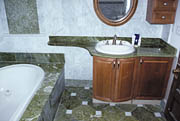

Natural stone was used throughout the home, primarily in the bathrooms. Ozer White and Oriental Green marble were used throughout the entire master bath. The Oriental Green marble was recommended to the architect by Ozer International, LLC, a stone importer based in Harrison, NJ, and it was instantly chosen for its unique green color. Segal explained that the "algae-colored" green marble blends beautifully with the Ozer White tiles, adding overall elegance and timeless beauty to the master bath. The Oriental Green was used for the area around the tub deck, the countertop and the floor. "Stepping out on a stone floor is a much nicer feeling than stepping on a ceramic floor," explained Segal. "And another advantage of using stone is that if it chips, the color won?t chip off like ceramic." The 12- x 12-inch Ozer White tiles were employed for the walls, with smaller pieces used as decorative design squares for the floor.
A round-top, see-through opening was installed between the shower and tub wall to create a faux shower window. For the opposite wall of the bathroom, the architect used the window?s reflection to create a frame built into the wall bearing the same shape. The frame was filled in with a mosaic made up of the Oriental Green and Ozer White stones to create a beautiful wall design for the bathroom. A piece of Ozer White marble was half embedded into the wall, which sticks out beyond the edge of the wall as a console, giving the illusion of windowsill. "We wanted to give the impression of an old enclosed window," said Segal. A mosaic trim was also installed behind the sink vanity. "Good detail work really makes a difference in a bathroom or kitchen," explained Segal.
For the upstairs bathroom, the architect decided to use a mosaic floor pattern made of marble. He selected pieces that he felt captured an "Old World" look. Approximately 60 square feet of the marble mosaic was employed and laid in a brick pattern for the bathroom floor. In addition, 300 square feet of 12- x 12-inch Ozer White tiles were installed around the tub deck and countertop, The white marble was accented by a border of 1- x 2-inch pieces of tumbled Teos Green marble to contrast the tiles and give a visually appealing effect, according to Segal.
Smaller stones handset in a mosaic pattern worked best for the project because of their strength and durability under certain conditions. Unlike larger pieces of stone tile, they would be less likely to crack, according to the architect. Cementitious backerboards, 1/2 inch thick in size, were also installed under the mosaic and glued to the floor. "My inspiration was to create the same affect as the Villa of Casale, an old, historic home in Sicily," said Segal. "It had the most wonderful floor mosaics, with 30 million mosaic pieces, which were still almost intact after the rest of the house was buried and destroyed by an earthquake and a landslide. Since this house is very old, I was concerned to use big pieces because they are more likely to have movement and crack, so I used small pieces on a handset mesh," explained Segal.
Installing marble tiles in combination with mosaics was a slow process, according to the architect and installer. "We had to do the work in stages until the first few rows at the bottom were completely dried before continuing the process -- the most we could do was three or four rows at a time," said Segal. Not only was the process of installing a mosaic pattern time consuming, but it also required a high degree of precision, according to the architect. "We had to cut the design to make some of the pieces round, which was difficult," said installer Ekrem Tasci of Ozer International, LLC. "The mosaic floor was most difficult to install because we needed [the design] to be straight and exact." In addition, a water-resistant backerboard had to be installed because the house was not lined with sheet rock. Installing the sheet rock created an extra step for the workers. "Because this house is lined with plaster not sheet rock, we had to clean out the plaster and install completely new cement boards in some areas," said Segal.

CREDIT BOX:
Private ResidenceRidgewood, NJ
Architect: Gary Segal Architect & Planner, Ridgewood, NJ
Stone Installer & Supplier: Ozer International, LLC, Harrison, NJ



